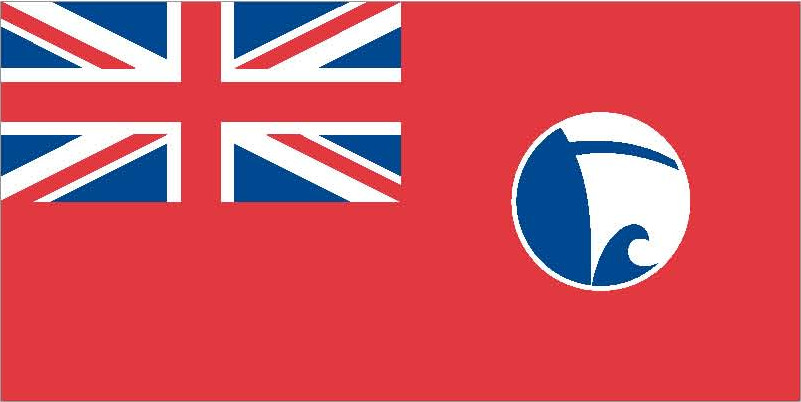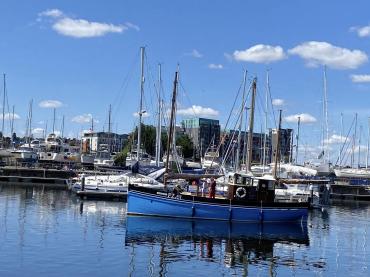Details
Construction
Dimensions
History
The Cornish lugger IBIS (FY 519) was built in 1930 by Percy Mitchell, of Portmellon, near Mevagissey, for the two Lakeman brothers. Her hull was of pitch pine planking on oak frames. She had two 7hp Kelvin petrol/paraffin engines and the traditional dipping lug on the mainmast with a standing lug on the mizzen. She fished for pilchards with drift nets and also used long lines (with numerous hooks attached) in the Channel during the winter to catch turbot, ling, conger and ray. She was for many years the largest lugger to work from Mevagissey and was the first to go to sea on Sundays. In 1960 the Lakeman family sold her to an owner at Newlyn to continue fishing. By the mid-1960s she was sold again and worked as a crabber out of Salcombe, Dartmouth and Plymouth. In 1970 Robert Gavin found IBIS at Weymouth and had her refitted by Philip’s at Galmpton, on the River Dart. Herbie Uren bought her in 1975 and fished for mackerel and crabs out of Porthleven in West Cornwall. In 1978 she was sold again and given a full refit, including a new engine. She was then used to fish for mackerel, shark angling and trawling out of Looe until the mid 1980s, and in 1989 was restoredto sail with the traditional lugger rig.
She was sold to a Brixham owner in 2002 and is now based at Dartmouth. Although major work has been done on her hull, decks and masts to keep her seaworthy she is said to remain at least 80% original.
Source: Historic Sail, Britain's surviving working craft, Paul Brown, the History Press.
Update: as of November 2021, IBIS has been "adopted" by Lynher River Barge CIC, who are raising funds for her restoration. Once restored, they intend to use IBIS alongside their Tamar barge LYNHER to promote a sustainable food economy in the South West and to sail fair trade produce to the coastal communities of Devon and Cornwall.
Update, December 2022: Lynher River Barge CIC has been awarded £247,625 by The National Lottery Heritage Fund to restore Ibis and create the Sail Trade South West project. The project will start in early 2023 and end in August 2024.
Significance
- What is the vessel’s ability to demonstrate history in her physical fabric? Evidence for designs, functions, techniques, processes, styles, customs and habits or uses and associations in relation to events and people. How early, intact or rare these features are may impact on significance.
IBIS FY519, was constructed by Percy Mitchell, a self-taught naval architect and respected boatbuilder, in a traditional fishing boat style using pitch pine on grown oak frames. At build, she was one of the largest fishing boats in Mevagissey and one of the first to have engines being fitted with a Rustin and a Kelvin. She was tight planked with no caulking between the seams which was innovative for the time and is one of the reasons her hull has survived. IBIS was rigged with a lug foremast and boom mizzen. Eighteen months later, a wheelhouse was fitted, the tiller was replaced with chain steering, her foremast was replaced with a lighter spar and a tabernacle was also added. Her planking, keel and garboards are original, although conservation work is required which will mean the introduction of new material. Her hull form remains intact, as does her lug rig and she retains her deep cargo hold. There have been minor adaptations to the vessel’s fabric in the past, such as the introduction of a steering cabin, which it is intended will be removed to return IBIS as closely as possible to her original specification. Maintenance work and changes over the years include the installation of a new plywood deck on canvas sheathing which will also be removed to reinstate a traditional deck more in keeping with the original construction. Her original engines have not survived, with IBIS being fitted with 28 different engines during her life to date.
2. What are the vessel’s associational links for which there is no physical evidence?
Associations with people or places. Off-ship research.
Percy Mitchell was one of the best known and most respected Cornish boatbuilders of his era. IBIS was his first major commission and her build is described in his autobiography A Boatbuilder’s Story. She was built for the Lakemans - a fishing family from Mevagissey - and has strong regional associations to the fishing and traditional boat community across Cornwall. As one of the biggest luggers working from Mevagissey, her catch numbers were legendary and IBIS is the holder of two fishing records. She has spent her entire life in the West Country, first working out of Mevagissey, then Mousehole and Newlyn, before moving to Salcombe, Dartmouth and Plymouth. She has the distinction of being one of the last working luggers to operate out of Looe in the 1980s and, in 1990, the Maritime & Coastguard Agency (MCA) granted her the honour of becoming a ‘historic fishing vessel’, allowing her to wear her (defaced) registration numbers and letters with pride. During the Second World War, IBIS was shot by a German bomber which is believed to have inspired the fictitious novel Evening Star, written by Ken Sherwood of Mevagissey. IBIS has taken part in the famous Looe Lugger Regatta which was re-instated by the Cornish Lugger Association as a bi-annual event in the 1990s. Unfortunately, her original lines drawings do not survive, but her build is well described in Percy Mitchell’s book, along with images of her under construction. The sign of Percy Mitchell’s Boatyard still hangs on the wall of the cottages that took its place at Port Mellon. IBIS has been listed on the National Register of Historic Vessels since 2007.
3. How does the vessel’s shape or form combine and contribute to her function?
Overall aesthetic impact of the vessel, her lines, material she was built from and her setting. Does she remain in her working environment?
IBIS was built to work as a fishing boat with a deep cargo hold to store catches of pilchards, herring and turbot whilst returning them to harbour. Constructed as a motor boat, she has a different form to earlier fishing luggers which had finer lines aft. IBIS retains her shape and the distinctive lug rig which is aesthetically pleasing, particularly when seen sailing in her native Cornish waters. She is currently undergoing stabilization prior to a conservation project, with the aim of returning her to operational use as a sail cargo carrier along the Cornish coast, giving her a heritage use not dissimilar from the purpose for which she was built nearly a century ago.
Sources:
‘A Boatbuilder Story’ 1968 Percy Mitchell. Published by Kingston. Mevagissey. Cornwall
Author:
Barbara Bridgman
23/06/2022
Grants
-
December 2022
Lynher River Barge CIC has been awarded nearly £247,625 by The National Lottery Heritage Fund to restore Ibis and create the Sail Trade South West project.
Own this vessel?
If you are the owner of this vessel and would like to provide more details or updated information, please contact info@nationalhistoricships.org.uk









